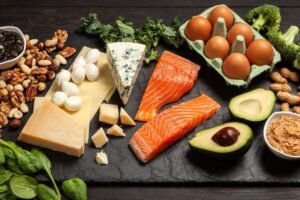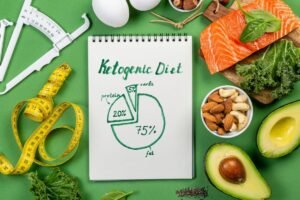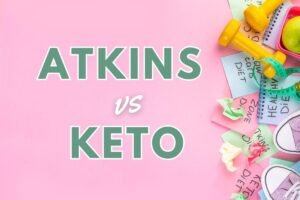The ketogenic diet, or “keto” for short, is a popular choice for losing weight and improving health. It focuses on eating low-carb and high-fat foods. This approach helps your body enter a state called ketosis.
If you’re thinking about trying the keto diet, you’ll find many tasty foods to enjoy. You can eat everything from protein-rich foods to healthy fats and low-carb veggies. This makes the keto diet very versatile in the kitchen.
Click Here to Get Your custom diet plan
Table of Contents

Key Takeaways
- The keto diet focuses on low-carb, high-fat foods to induce a metabolic state called ketosis.
- Protein-rich options like meat, poultry, eggs, and seafood are keto-friendly staples.
- Healthy fats such as avocados, olive oil, nuts, and seeds are essential components of the keto lifestyle.
- Low-carb vegetables, particularly leafy greens and cruciferous veggies, are encouraged on the keto diet.
- Incorporating dairy and low-carb fruits can add variety to a keto meal plan.
Understanding the Keto Diet
The keto diet, also known as the ketogenic diet, is a popular low-carb lifestyle. It helps the body enter a state called ketosis. In this state, the body burns fat for fuel instead of carbs. By eating fewer carbs and more healthy fats, people can lose weight and control their blood sugar.
Get Your Custom Keto Diet Plan Now
What is the Ketogenic Diet?
The ketogenic diet is high in fat, moderate in protein, and low in carbs. Eating fewer carbs makes the body use fat for energy instead of glucose. This can lead to many health benefits, such as:
- Accelerated weight loss
- Improved blood sugar regulation
- Increased mental focus and energy
- Reduced inflammation
- Enhanced heart health
Benefits of Following a Keto Diet
The keto diet helps with weight loss and better health. By eating fewer carbs, the body uses fat for energy. This can lead to losing body fat. It also helps control blood sugar, which is good for people with type 2 diabetes or insulin resistance.
“The keto diet has helped me lose weight and feel more energized than ever before. It’s a game-changer for my overall health and well-being.”
The keto diet offers more benefits, like better mental clarity, less inflammation, and better heart health. By eating more healthy fats and fewer carbs, people can see many positive changes in their health.
Keto-Friendly Protein Sources
Starting a keto diet means you need to think about getting enough protein. Protein is key for keeping muscles strong, helping your body work right, and making you feel full. Luckily, the low-carb lifestyle of the ketogenic meal plan offers many keto-friendly protein choices for your meals.
One big plus of the keto diet is eating healthy fats. These fats help with weight loss and keeping you in ketosis. By eating low-carb, high-protein foods, you can make a keto-friendly meal plan. This plan helps with your weight loss strategy.
Lean Meats and Poultry
Lean meats like chicken, turkey, and pork are great for keto-friendly protein. They’re low in carbs, perfect for a low-carb lifestyle. You can grill, bake, or roast these proteins and add them to many ketogenic dishes.
Eggs and Seafood
Eggs and seafood are great keto-friendly protein choices. Eggs are easy to make and full of protein. They can be scrambled, poached, or in a frittata. Fatty fish like salmon, tuna, and mackerel give you protein and healthy fats.
Plant-Based Proteins
For a plant-based keto diet, there are many low-carb, high-protein foods. Tofu, tempeh, nuts, and seeds are good for keto-friendly protein. Adding these to your meals makes your diet more varied and ensures you get enough protein.
By choosing these keto-friendly protein sources, you can make a balanced ketogenic meal plan. Try different cooking ways and flavors to keep your meals tasty and interesting.

Healthy Fats for Ketosis
On the keto diet, healthy fats are key for ketosis and health. Foods like avocados, olive oil, nuts, and seeds are great for your ketogenic meal plan. They fuel your low-carb lifestyle and help with weight loss.
Avocados and Olive Oil
Avocados are packed with healthy fats, fiber, and important vitamins and minerals. They boost your monounsaturated fats, which are good for the heart and make you feel full. Olive oil is also keto-friendly and full of antioxidants. It helps fight inflammation.
Nuts and Seeds
Nuts and seeds are great for the keto diet too. Almonds, walnuts, chia seeds, and flaxseeds are low in carb restriction but high in fiber, protein, and fats like omega-3s. Adding these to your meals and snacks helps you stay in ketosis and supports your health.
| Fat Source | Key Benefits |
|---|---|
| Avocados | Rich in monounsaturated fats, fiber, and essential vitamins and minerals |
| Olive Oil | High in antioxidants and offers anti-inflammatory properties |
| Nuts and Seeds | Low in carbs, high in fiber, protein, and omega-3 fatty acids |
Adding these healthy fats to your ketogenic meal plan helps you stay in ketosis. This supports your health and weight loss goals.

Low-Carb Vegetables to Embrace
Starting a keto diet or low-carb lifestyle means eating nutrient-rich vegetables is key. These foods are vital for your ketogenic meal plan. They give you vitamins, minerals, and fiber to stay energized and full.
Leafy Greens and Cruciferous Veggies
Leafy greens like spinach, kale, and arugula are must-haves for the keto diet. They’re low in carbs but high in fiber and antioxidants. These help with weight loss strategies and boost your health. Cruciferous veggies, such as broccoli and cauliflower, are great too. They’re low in carbs and full of healthy fats that help you stay in ketosis.
- Leafy greens: Spinach, kale, arugula, Swiss chard, romaine lettuce
- Cruciferous veggies: Broccoli, cauliflower, Brussels sprouts, cabbage, radishes
These veggies make your keto-friendly meals tasty and nutritious. They’re packed with vitamins A, C, and K, plus minerals like calcium, iron, and magnesium. Adding them to your carb restriction plan helps you get the nutrients you need. It also supports your weight loss strategy.
“Leafy greens and cruciferous veggies are the backbone of a successful keto diet. They provide the essential nutrients your body needs while keeping your carb intake low.”
Keto Diet: Beyond the Basics
The keto diet is known for its focus on high-fat, low-carb foods. But, smart keto followers know they can add many nutrient-rich foods to their meals. This includes dairy and low-carb fruits, which add nutrients and variety to the keto diet.
Incorporating Dairy and Low-Carb Fruits
Dairy products are great for the keto diet if chosen right. Full-fat cheeses, heavy cream, and plain Greek yogurt are good choices. They add creaminess and nutrition to meals and snacks.
Low-carb fruits like berries are also great. Blueberries, raspberries, and blackberries are good because they’re low in carbs but high in fiber and antioxidants.
Adding these foods to a keto diet makes meals diverse and satisfying. It supports weight loss and health goals. Just remember to watch portion sizes and track carbs to stay in ketosis.
“The keto diet is not just about giving up carbs – it’s about finding creative ways to make nutritious, delicious meals that fit your lifestyle.”
By trying new recipes with dairy and low-carb fruits, keto followers can keep their meals exciting. This helps them stick to the keto diet and reach their healthy fats-based weight loss goals.
Strategies for Successful Keto Meal Planning
Starting a keto diet means you need to plan your meals well. This helps you stay in ketosis and enjoy the benefits of a low-carb lifestyle. With good keto meal planning, you can make a meal plan that helps you reach your health and weight goals.
Adding healthy fats to your meals is key to good keto meal planning. Foods like avocados, olive oil, nuts, and seeds are great. They give you important nutrients and make you feel full, so you won’t want to eat too many carb-rich foods.
- Plan your meals in advance: Set aside time each week to plan your keto-friendly meals. Make sure to include lots of low-carb vegetables, proteins, and healthy fats.
- Batch cook or meal prep: Cook big batches of keto-approved dishes that you can eat all week. This makes it easier to follow your weight loss strategy.
- Experiment with new recipes: Look for keto-friendly recipes online or in cookbooks. Try new ingredients and flavors to keep things interesting.
- Embrace meal simplicity: Sometimes, the easiest keto meals are the best. Think about making a simple grilled salmon fillet with roasted broccoli and avocado.
- Stay hydrated: Drink lots of water all day to help your ketosis and health.
Using these tips for keto meal planning will help you reach your weight loss and health goals. You’ll enjoy tasty, healthy meals that keep you full and give you energy.
| Keto-Friendly Meal Planning Tips | Benefits |
|---|---|
| Plan meals in advance | Ensures you have keto-approved options ready, helping you stick to your low-carb diet |
| Batch cook or meal prep | Saves time and helps you follow your ketogenic meal plan all week |
| Experiment with new recipes | Keeps your keto diet exciting and introduces you to more healthy fats and low-carb vegetables |
| Embrace meal simplicity | Even simple keto-friendly meals can be satisfying and full of nutrients |
| Stay hydrated | Helps with ketosis and overall health, which can boost your weight loss efforts |
“Successful keto meal planning is the foundation for a sustainable and rewarding low-carb lifestyle.”
Conclusion
The keto diet is full of tasty and healthy food choices. It helps you reach your health and wellness goals. You’ll find lots of protein-rich foods, healthy fats, and low-carb veggies.
By following the keto diet, you enter a state called ketosis. This state helps with weight loss, boosts energy, and improves brain function. It’s great for losing weight, managing health conditions, or just eating healthier.
When trying the keto diet, talk to your doctor and try out different recipes. Stay focused on your goals. With the right support and the keto community’s help, you can succeed in your new eating plan. Enjoy the many benefits it brings.
FAQ
What is the Ketogenic Diet?
The ketogenic diet is a low-carb, high-fat plan. It puts your body into a state called ketosis. In this state, your body uses fat for fuel instead of carbs. This can lead to weight loss and health benefits.
What are the Benefits of Following a Keto Diet?
The keto diet may help with weight loss, better blood sugar control, and less inflammation. It can also improve mental focus. Plus, it might help manage conditions like epilepsy and type 2 diabetes.
What Keto-Friendly Protein Sources Can I Eat?
Great protein sources for the keto diet include meat, poultry, fish, eggs, and some dairy. These foods are low in carbs but high in healthy fats. They’re perfect for a ketogenic lifestyle.
What Healthy Fats Should I Incorporate into the Keto Diet?
Healthy fats for the keto diet include avocados, olive oil, nuts, and seeds. These foods are packed with nutrients and support ketosis. They also offer many health benefits.
What Low-Carb Vegetables Should I Eat on the Keto Diet?
Great low-carb veggies for the keto diet are leafy greens like spinach and kale. Also, try cruciferous veggies such as broccoli and cauliflower. These veggies are nutrient-dense and help create balanced keto meals.
Can I Incorporate Dairy and Low-Carb Fruits into the Keto Diet?
Yes, you can add certain dairy products and low-carb fruits like berries to the keto diet. These foods add variety and nutrients to your meals. They keep you in a state of ketosis.
How Can I Succeed with Keto Meal Planning?
To succeed with keto meal planning, focus on creating balanced, nutrient-dense meals. Use keto-friendly cooking methods and include a variety of low-carb, high-fat foods. Meal prepping can also help.




